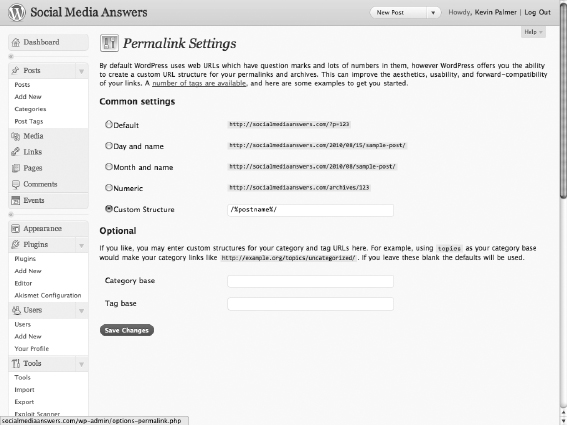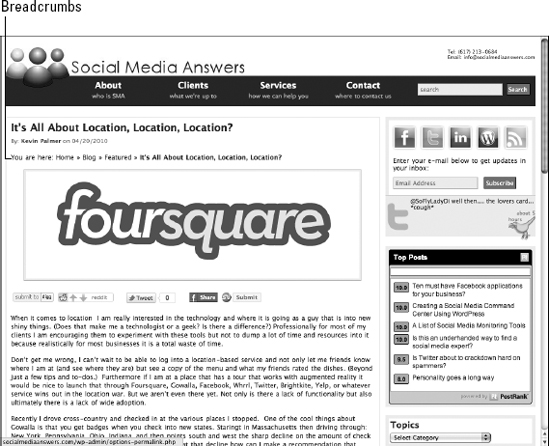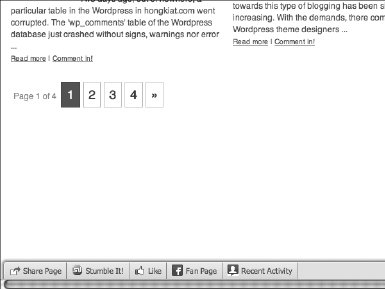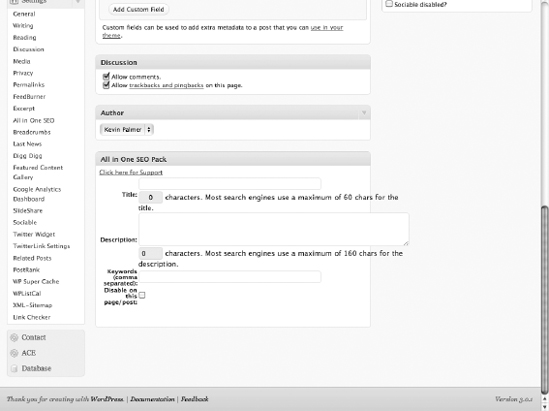Creating Search Engine Strategies
You can use the general concepts of why WordPress is good for SEO, the importance of your content, and researching your niche that we discuss in previous sections of this chapter when you set up your blog, write strategic content, and begin to build links into your Web site.
Setting up your blog
When setting up your blog, you are going to want to follow some best practices to make sure that your site is optimized for search engines. Some of these best practices include
- Permalinks: First, set up your permalink structure. Log in to your WordPress account and, on your sidebar, select Permalinks in the Settings section. The Permalink Settings page appears (see Figure 4-5). Select the Custom Structure radio button and type /%postname%/ into the text box.
Making this change gives you a URL that contains just your domain and the title of your blog post. If you use a really focused category structure in which you've carefully picked out keywords, you may want to add the category to the URL. In that case, you enter /%category%/%postname%/ in the text box.
Figure 4-5: The WordPress Permalinks Settings page.

Avoid using the default URL structure, which includes just the number of your post, and don't use dates in the URL. These numbers have no real value when doing SEO. WordPress by default numbers all your posts and pages with specific ID numbers. If you have not set up a custom permalink structure in WordPress, permalinks for your posts end up looking something like this: http://yourdomain.com/?p=12 (where 12 is the specific post ID number). Although these numbers are used for many WordPress features, including exclusions of data and customized RSS feeds, you don't want these numbers in your URLs because they do not contain any keywords that describe what the post is about.
Also, if you already have an established blog and are just now setting up these permalinks, you must take the time to install a redirection plugin. You can find several of these plugins available in the Plugin section on WordPress.org. You must establish a redirection for your older posts so that you don't lose the links that search engines, like Google and Yahoo!, have already indexed for your site. One good redirection plugin to use is simply called Redirection, and can be found in the WordPress plugin directory here: http://wordpress.org/extend/plugins/redirection.
- Privacy: You don't want your blog to fail to be indexed because you didn't set the correct privacy settings. In the WordPress Settings menu, click the Privacy link. In the resulting Privacy page, make sure that the I Would Like My Site to Be Visible to Everyone radio button is checked.
 The other radio button, I Would Like to Block Search Engines, but Allow Normal Visitors, if checked, blocks search engines, which kind of defeats the purpose of everything we discuss in this chapter.
The other radio button, I Would Like to Block Search Engines, but Allow Normal Visitors, if checked, blocks search engines, which kind of defeats the purpose of everything we discuss in this chapter.
Improving your blog's design
After improving your setup in the back end of your blog, you will want to make some changes to your design so your blog works better with search engines. Some improvements you can make to your theme templates include
- Breadcrumbs: Breadcrumbs, often overlooked when creating a Web site, provide the valuable navigation usually seen above the title on a blog post. (See Figure 4-6.) Breadcrumbs are pretty valuable for usability and search engine navigation. They allow the average user to navigate the site easily, and they help search engines determine the structure and layout of your site. A good plugin to use to create breadcrumb navigation is called Yoast Breadcrumbs and can be found in the WordPress plugin directory here: http://wordpress.org/extend/plugins/breadcrumbs.
Figure 4-6: Users and search engines can follow the breadcrumbs.

- Validated code and speed: If you're not a professional Web designer, probably you don't do a lot of coding to your site. So we don't go in-depth on the proper use of JavaScript or how best to optimize your code. But if you make some small edits to your WordPress installation or add a lot of code through widgets, do it properly by putting it directly into your CSS, rather than coding into your site. Coding these features properly helps improve the speed of your site, how quickly it loads, and how search engines crawl the site. Book VI contains a great deal of information about coding the templates in your theme; check out that book for more information about correct coding.
When it comes to improving site speed, proper code has a lot to do with the performance of your site. You can take other steps to help improve the speed of your site, such as installing caching plugins, such as the W3 Total Cache plugin (http://wordpress.org/extend/plugins/w3-total-cache). The quality of your hosting (Book II, Chapter 1), the size of your image files (make sure that you set image-file quality to Web standards), the amount of images you're using, and third-party widgets or scripts (like installing a widget provided by Twitter or Facebook) can all impact the speed and performance of your site. If you are putting special widgets developed by sites like blog catalog, traffic exchange sites, or banner exchange sites, these require information from other sites to load. Depending on these other sites for quick load times can often lead to slow loading times on your own site.
- Pagination: Another basic design feature often overlooked when setting up a site, pagination creates bottom navigation that allows people and search engines to navigate to other pages. (See Figure 4-7.) Pagination can really help both people and search engines navigate through your category pages.
Figure 4-7: Pagination in action.

Most themes don't have built-in pagination, so you have to add a plugin to accomplish this effect. A few of these kinds of plugins are on the market, and we recommend some in Book V, Chapter 5.
- Avoid sidebar bloat: If you have a huge blogroll, don't include it on your sidebar throughout the site. In fact, if you want to include something that huge, create a page for all your links; having them on your sidebar throughout the site slows down the speed in which the pages on your site loads in your visitors browser and with all these outbound links, it bleeds page rank all over the place. Remember: Links pass on authority, when you link to a site or a site links to you, the link is saying that your site has value for the keyword in the link. So evaluate the links that you have and think about whether you really want to link to that Web site.
Often, when bloggers start out, they sign up for every service under the sun, including Web sites that require you to place reciprocal links or banners on your Web page. All those links and banners quickly turn your Web site into a bad NASCAR car, and your site's performance degrades because it needs to load all those external codes. Be very picky about what you put into your sidebar.
Dealing with duplicate content
WordPress does have one major problem when it comes to SEO: It creates so many places for your content to live that duplicate content can confuse search engines. Thankfully, plugins and some basic editing easily take care of these issues.
First, take care of your archive page on your site, which is the page that displays archives such as category, date-based archives, and so on. You don't want your archive page to present full blog posts, only truncated versions (short excerpts) of your posts. Check your theme to see how your archive is presented. If your archive shows complete posts, see whether your theme has instructions about how to change your archive presentation. (We can't give you a single way to make this change because each theme is unique, but check out the information in Book VI; it is full of great information about tweaking and altering theme template files.)
Additionally, make sure that search engines aren't indexing all your archives by using a robots plugin. (We cover plugins in Book V, Chapter 5.) You want robots going through only your category archive, not the author index and other archives.
Creating an editorial SEO list/calendar
We're not going to take the fun out of blogging by telling you that you need to plan out your posts from now until the end of time. Still, it doesn't hurt to create a list of some of the keywords that your competitors rank for and some of the content they've discussed. Take that list and apply it to new posts, or write evergreen content (topics that aren't timely) centered around what you want to say. Planning out your blog can really help in figuring out what keywords you want to target when you want to write content to improve for ranking for targeted keywords.
If you feel that your blog is more news- or current-events oriented, create a reference list of keywords to incorporate into your newer posts so that you can rank for these targeted terms.
Establishing a routine for publishing posts on your site
Although you can't really call this high strategy, getting into the habit of posting content regularly on your site helps you get the basics down. Here are some things to keep in mind:
- Properly title your post. Make sure that your post includes the keyword or phrase for which you're trying to rank.
- Fix your URL. Get rid of stop words or useless words from your URL and make sure that the keywords you want to target appear in the URL of your post. Stop words are filler words such as a, so, in, an, and so on. For a comprehensive list of stop words, check out this list: http://www.link-assistant.com/seo-stop-words.html
- Choose a category. Make sure that you have your categories set up and that you properly place your post into the category it falls under. Whatever you do, don't use the uncategorized category — it brings no SEO value to the table.
- Fill out metadata. If you're using a theme framework, the form for metadata often appears right below the post window. If you aren't using a theme framework, you can use the All in One SEO Pack plugin (we talk about this plugin in a previous section). When activated, this plugin usually appears toward the bottom of your posting page. (See Figure 4-8.) Make sure that you completely fill out the title, description, keywords, and other information the plugin or theme framework asks for.
- Properly tag posts. You may want to get into the habit of taking the keywords from the All in One SEO Pack plugin and pasting them into the tags section of the post.
- Fill out image info. Take the time to completely fill out your image info when you upload pictures to your posts. Every time you upload an image to WordPress, a screen will appear in which you can fill in the URL slug, description, and alt text for the image you have uploaded.
Figure 4-8: The All in One SEO Pack's metadata form.

Creating a link-building strategy
In previous sections of this chapter, we tackle most of the onsite SEO strategy and concepts. In this section, we explain how you can start working on your off-page strategy. Here are some things to keep in mind:
- Fill out your social media profiles. As we discuss in Chapter 1 of this minibook, a lot of social-media sites pass on page rank through their profiles. These sites allow you to link to yours with a descriptive word and these major sites say that this link has value to search engines. Also, most profiles allow you to link to your Web site. Take the time to fill out your social-media profile properly and list your site in these profiles.
- Use forum signatures. If you participate in forums, you can easily generate traffic and earn some links to your Web site from other Web sites by including your site URL in your forum signature.
- Examine your competitor's links. See where your competitors or other people in your niche are getting links — directories, lists, guest blogs, friends? — and then try to get links on those sites. Try to determine the relationship and figure out whether you can establish a relationship with that site, as well.
- Guest blog. Find some of the top sites in your niche, and then ask them whether you can guest blog. Guest blogging gives you a link from a respected source, as well as builds a relationship with other bloggers. Also, guest blogging can't hurt your subscriber numbers; often, you see a bump after you guest blog on a large site.
- Blog and Web site directory registration. Directory registration, albeit a time-consuming affair, can often provide a large amount of backlinks into your site from respected sources.
- Comment on other blogs. A lot of blogs pass on page rank because the links in their comment section are live. Make sure that when you participate and engage other bloggers, you properly fill out your information before you post, including the URL to your site. Don't start posting inane comments on random blogs in order to get links — it is considered rude to do that to other bloggers and can lead to your blog being marked as spam in various commenting systems.
- Participate in social bookmarking. Getting involved in Reddit, Digg, and other social-bookmarking communities allows you to participate in social media with people who have similar interests, and you can build links into your site by submitting content to social-news and bookmarking sites.
